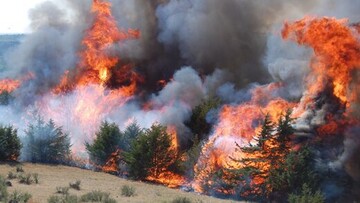• What are the principal causes of forests fires?
Globally, people are the cause of 90% of fires globally through a combination of poor practice, limited access to alternative approaches to fire, accidents, weak understanding of fire risk, machinery, negligence and carelessness. Natural fire causes are limited to lightning ignited fires.
Fires have been used by humans for millennia and play a critical role in many ecosystems. The use of fire for hunting, favouring preferred plants for food, fodder or fibre, clearing for agriculture and grazing, easing travel and controlling pests is well documented, historical and continues today. This is particularly the case in developing countries where people depend directly on forests and agriculture for their livelihood and food security.
• What kinds of factors may facilitate, intensify and speed up the occurrence of forests fires?
Although wildfires are most often initiated by human actions, their intensity and their effects are mainly driven by fuel condition and availability, vegetation structure and meteorological and topographic conditions.
The amount and type of fuel is directly related to the intensity of the fire.
The effects of fires are related to the intensity of the fire, how much energy is released by the fire as it burns.
The weather conditions, particularly the wind strength, directly influence fire behaviour, especially the speed of the fire front, known as the rate of spread.
The occurrence of forest fires is related to:
The amount of fuel available to burn.
The dryness of the fuel, which is the result of the annual dry seasons when there is a lack of rainfall or drought.
The activities of people are the main source of forest fire ignitions.

• What policies, measures, and practices can authorities adopt to prevent or mitigate the effects and extent of forests fires?
FAO’s wildfire work includes lessons learned from wildfire risk reduction and emergency response to current hazards and support for long-term climate change adaptation and mitigation efforts. Key to successfully integrating ecology, society and fire management technologies is effective analysis of the situation to underpin Integrated Fire Management.
The most important practice to adopt is to systematically Review and Analyse fires in Iran. Where do they occur? How many? How large? What time of year? What are the sources of fires? Who lights the fires? Why do they light the fires?
Data on fire incidence is weak in many countries. The combination of existing data sets, remote sensing data and historical information applied at national level will vastly improve understanding by countries of their wildfires. This step of Review and Analysis of fires is essential in planning for Risk Reduction, Readiness to fight wildfires, Response to wildfires and Recovery of the restoration of landscapes, livelihoods and assets impacted by wildfires.
It is important to stimulate understanding and encourage acceptance of the concept of Integrated Fire Management as a comprehensive, balanced system including Research and Analysis, Risk Reduction, Readiness to fight wildfires including monitoring and early warning early action, Responding to wildfires and Recovery efforts for communities, assets and landscapes from wildfires (the 5Rs).
• What kind of environmental consequences are expected to be emerged/experienced in the aftermath of such incidences?
Fire can remove large amounts of biomass and cause negative impacts on the production of ecosystem goods and services such soil erosion, water runoff, air pollution, and timber production. Fire is also a factor in desertification and land degradation.
Wildfires cause considerable damage to landscapes and impact environmental services. Changes in freshwater availability and degradation of water supply is an indirect impact that is receiving increased attention with potentially millions of people - including in cities - at risk of water shortages as a result of wildfire activity in watersheds.
The changes in global fire activity in terms of location, intensity, severity, and frequency (termed the fire regime) will likely have deep and long-lasting impacts on biodiversity and ecosystem services.
• How the human being and local communities can be affected by the forest fires and their subsequent impacts?
Economic Damage and Loss
Wildfires cause damage to infrastructure and services, including power, water, and communication lines, roads and railways as well as the immediate costs of firefighting. Additionally, there are tremendous costs associated with rebuilding homes, businesses, and entire communities that have been damaged or destroyed by a major fire event.
Wildfires can affect livelihoods and food sources, along with ecological effects, can also be long term and negative, with the potential to impact on food security and ecological sustainability.
• Does FAO have any specific programme, framework, or recommended policies, measure and practices on forest restoration that can be lent to or shared with member countries?
FAO has long had a programme on wildfire management and has unique global to local reach, experience, technical capacity and networks among the many disciplines and sectors across which fires impact. It has contributed an invaluable body of work on fire management including a series of publications and programs; services to its member countries; and engagement in joint initiatives with many other international organisations, multi-lateral agencies, development partners, NGOs and INGOs and networks.
With partners from around the world, FAO produced the Voluntary Guidelines: Principles and Strategic Actions, which is available in multiple languages and a Review of Community Based Fire Management (CBFiM).
• In terms of forest restoration, is it ever possible to restore these natural resources entirely and how long is it expected for these processes to take?
The restoration of a landscape following an impact or change such as a wildfire is possible and has been carried out over the years. The difficulties of effective restoration include knowledge and management of restoration techniques, resources (funding but also human capacity, technical knowledge and effective institutions) and long term commitment to enable recovery to take place. The ecology of the area, the fire impacts and the ongoing use of land for various purposes will all have an influence on the length of time taken to fully restore natural resources.
• What kind of assistance does FAO offer to Iran, supporting the country’s efforts in preventing and mitigating both the damages caused by the forests fires?
FAO works in partnership with the member nations and responds to their requests and works with them to improve agriculture, fisheries and forestry.
In the past FAO has worked with Iran on forest fire management through a Technical Cooperation Project on Assistance to Strengthening the Resilience of Zagros Forests to Oak Decline and Caspian Forests to Boxwood Blight and Development of National Forest Monitoring System in the Islamic Republic of Iran. This project had a role in establishment of the National Forest Monitoring System.
FAO can assist process with the examples of methods and tools currently being develop and applied (for example in Cambodia, Lebanon, Algeria and Kenya) and other materials and information.
The Fire Management Voluntary Guidelines provide a set of ideas to use in assessing needs
Reports by IUFRO and World Bank provide a set of concepts to keep in mind
The FAO Fire Management Strategy provides a systematic approach to building a soundly based and sustainable fire management system


Your Comment